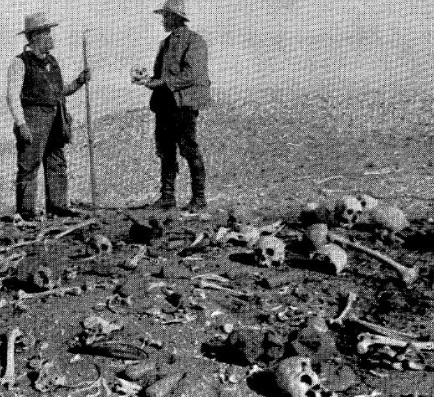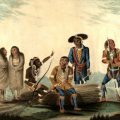
During the last part of the nineteenth century some of the American settlers in the west, and particularly in California, began hunting and killing Indians for sport. Between 1847 and 1865 American hunters killed 4,267 Indians in California. In contrast, the Indians killed fewer than 300 Americans. By 1890, California’s Indian population was estimated at 15,238, down from an estimated 300,000 in 1848.
One of the Indian hunters in Northern California describes an Indian he was hunting as:
“dodging and ducking through the thickets like frightened deer. I brought down one with a shot from my double-barrel, but he was up and streaking it [sic] through the brush before I could lay hands upon him. Several of us followed him for a half-mile or more down the slope towards Little Dry Creek before we finished him.”
Organized groups of men hunted Indians and often bragged at the number they had killed. Baptist missionary Lee Thayer, writing in 1922, reports:
“Ezekiel Merrit, Commander of the Bear Flag Party, boasted nearly one hundred notches on his tomahawk handle, his record of Indians kills. Indian villages were used as targets for rifle practice and Indians were wantonly destroyed by the wholesale.”
The underlying reasons for exterminating the Indians were in part racism and the belief that Indians were somehow “not human”, and in part the ethnocentric view that Americans had a superior right to the land. Seizing beautiful California from the Indians and the Mexicans, in the minds of many American settlers, was not just self-interest but a moral duty and a boon to humanity’s progress.
In 1859, the superintendent for Indian affairs reported that the killing of Indians by unauthorized expeditions was a daily occurrence. He went on to warn that if the expeditions were not restrained the Indians would soon be exterminated.
In response to the report by the superintendent for Indian Affairs, a special treasury agent investigated the California situation. He reported that one man, with a commission from the governor of the state, had raised a company to slaughter Indians without regard to age or sex. Special Treasury Agent J. Ross Browne reported to Congress on his observations of the situation of the Indians in California:
“In the history of Indian races I have seen nothing so cruel and relentless as the treatment of these unhappy people by the authorities constituted by law for their protection. Instead of receiving aid and succor, they have been starved and driven away from the reservations, and then followed into their remote hiding places, where they sought to die in peace, and cruelly slaughtered, till but few are left, and that few without hope”
He suggested that military force would be needed to stop the genocide.
In 1860, a group of 50 to 75 prominent men of Humboldt County held a secret meeting to solve the “Indian problem.” They felt that extermination was the quickest and cheapest solution. They carried out their policy of extermination in a series of raids on peaceful villages. There was no pretext of retaliation which could have been used to justify the attacks. Their attacks were done with no official sanction. In all, they killed more than 300 Indian men, women, and children on Indian Island in Humboldt Bay. Unarmed women and children were often killed with clubs, hatchets, and knives. One of the ringleaders boasted that he had killed 60 infants with his own hatchet.
In Union, California, Bret Harte wrote an editorial for the Northern Californian in which he criticized the killing of Indians by Anglos. He called the killings “shocking and revolting.” Local citizens were so outraged by his criticism that Harte was forced to resign and leave town.
By 1861, American settlers were regularly seizing Indian children and selling them into slavery. In the Sacramento Valley, Indian boys were selling for $60 while girls, who were used for both labor and sex, could sell for up to $100. The Indian agent reported:
“These crimes against humanity so excited the Indians that they began to retaliate by killing the cattle of the Whites.”
The U.S. Army the retaliated against the Indians. The Indian agent reported:
“Ten kidnappers follow at the heels of the soldiers to seize the children when their parents are murdered and sell them to the best advantage.”
When the regular army troops were ordered east to fight in the Civil War in 1861, volunteer troops in the Eel River area took charge of Indian affairs. The volunteers set out to kill all Indians they could find and killed 77 Indians by the end of the year.
In 1862, non-Indian squatters entered the Round Valley Reservation and began to harass the Konkow and Atsugewi. The Indian agent provided no aid to the Indians. A war party of about 25 well-armed Americans surrounded an Indian camp and massacred 45 people. Fearing that they would be killed, 461 Konkow and Atsugewi fled from the reservation to the Chico area. The Red Bluff Herald reported:
“It is becoming evident that extermination of the red devils will have to be resorted to before the people … will be safe”
In another incident, two Indians from the reservation were accused of killing two non-Indian boys. They were tied to a tree and scalped. The squatters then demanded that the Indians be removed from their reservation or be exterminated.
The squatters attacked a Wailaki camp on the reservation and massacred 20 men, women, and children. As a result of this incident, martial law was declared and army troops entered the reservation. The squatters blamed the Indians for burning a barn and in response the army executed five Indians while the squatters destroyed the Indian crops. Instead of providing security for the reservation, the army troops further agitated the natives when the soldiers seized a number Indian women for their sexual pleasure.
In 1866, the Chico Courant reported:
“It is a mercy to the red devils to exterminate them, and a saving of many white lives. Treaties are played out-there is only one kind of treaty that is effective-cold lead.”
In 1867, 45 Yana were killed at Dye Creek. The bodies were left on the ground as there were not enough Yana left alive to bury them. In a period of about 20 years the Yana had been reduced from 1,900 individuals to probably fewer than 100 while the deaths of fewer than 50 settlers can be attributed to them with any degree of certainty.

Leave a Reply